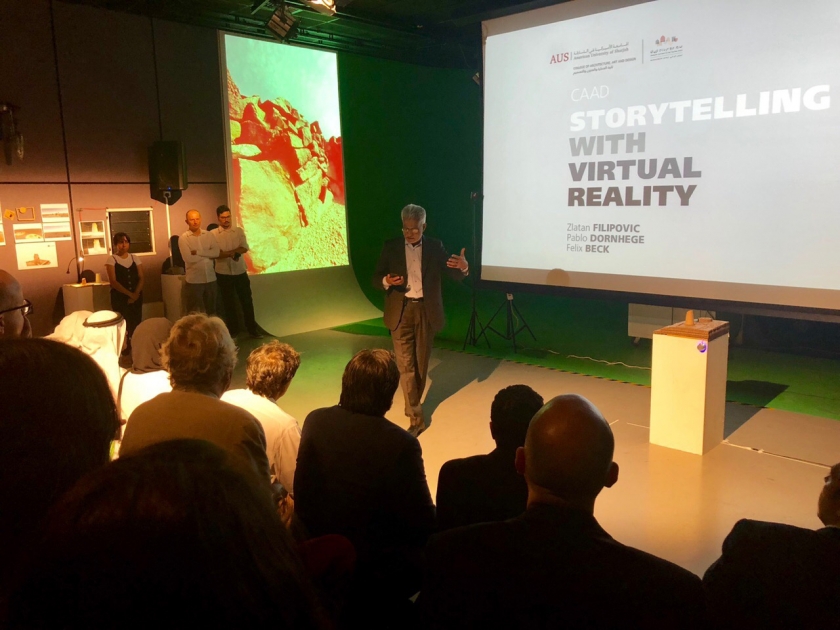
SGTS and AUS Turn UAE Heritage Site into Interactive Virtual Reality Destination
The remarkable historic story of Wadi Al Helo – one of Sharjah’s UNESCO World Heritage-nominated cultural heritage sites – is being told using a unique Virtual Reality (VR) application developed by the management office of ‘Sharjah: The Gateway to Trucial States’ (SGTS), and the American University of Sharjah (AUS) in an effort to highlight Sharjah’s important role in the region’s economic and political history.
The nomination “Sharjah: Gateway to the Trucial States” (SGTS) is the city’s bid to include eight of the Emirate’s cultural heritage sites on the prestigious list of World Heritage Sites by UNESCO. Besides the historic village in Wadi El Helo, the nomination also includes the Historic Town of Sharjah (Heart of Sharjah), Al Hisn, Al Mahatta Airport, Al Mirgab Camp, Al Dhaid, Fili Forts, and Khorfakkan Archaeological site. A first-of-its-kind collaboration aimed at preserving Sharjah’s heritage sites, both the SGTS and AUS support it.
The virtual reality project was implemented by AUS’s College of Architecture, Art and Design (CAAD), under the supervision of Dr. Varkki Pallathucheril, Dean of the University's College of Architecture, Art and Design (CAAD) and Zlatan Filipović, Associate Professor of Art and Design and Interim Head of the Department of Art and Design at CAAD.
Wadi Al Helo, with its historic village and several watchtowers, played an essential role in the history of Sharjah and is considered an important cultural site in the UAE. Engulfed by the mountains along the caravan route, the valley was secured by watchtowers located at its entrance to protect it from raiders. Known as a safe haven, it allowed its communities to work in agriculture and then export their products to coastal areas.
SGTS Management Office Director Khuloud ALHOULI emphasised the significance of the project for the wider UAE community at the heritage, cultural and social levels.
“We initiated this VR project with a pilot case of Wadi El Helo as part of the SGTS strategic vision to communicate the uniqueness of these sites to the world. At the same time we wanted to create an opportunity for the young generation to explore and engage in authentic Emirati heritage through the utilisation of modern technology and virtual reality that appeal to them,” said ALHOULI.
“The SGTS project is for the entire nation of the UAE. While we always seek to engage the various sectors of the UAE community with our cultural heritage, the SGTS nomination project provides a unique and specific platform to share our rich history with all members of the public,” ALHOULI added.
She continued: “We are very thankful to the AUS’s CAAD team who hugely welcomed this idea and provided outstanding support. With their expertise, we have created a unique and innovative experience through the merging of heritage and technology, which really speaks to today’s technologically savvy audience.”
The CAAD is looking forward to expanding collaboration with the SGTS to further develop the VR project, with the view to incorporate eight heritage sites across Sharjah which make up the UNESCO nomination, highlight their importance locally and internationally, and the reasons of selecting those sites to represent the fast pace of this region’s development.
Dr. Varkki Pallathucheril said: “It is such an honour to work on a project related to Sharjah’s rich history and cultural heritage. We tried to be different and tell the story of yesterday using today's technology. We hope to continue doing the same for all the sites.”
The SGTS-AUS collaboration includes Filipović, Pablo Dornhege from Berlin University of Arts and Felix H. Beck from New York University Abu Dhabi, in cooperation with Berlin University of Arts in Germany and New York University’s NTSI Lab.
“Our intention was to use virtual reality (VR) technology to bring to life the stories of the historic valley. This was an excellent opportunity to demonstrate how storytelling through VR can be used to enhance the way we understand the world, both past, present, and future" said Filipović.
“I am honoured to have been able to contribute to such an important project for our community,” said Filopović.
As an example of Reactive Immersive Cinema – which aims to move the audience from being mere spectators to actual participants in the story – the audience is positioned at a media station in the middle of several pre-recorded 360-degree videos. This allows individuals to experience the landscape of Wadi al Helo, while an interface with a rotational button allows them to pan across sections of the video.
The ongoing SGTS research project uses cutting-edge technology, such as photogrammetry, hypermedia, and user-experience design to create new ways of interacting with the various stories bound up in the history of the valley.


























